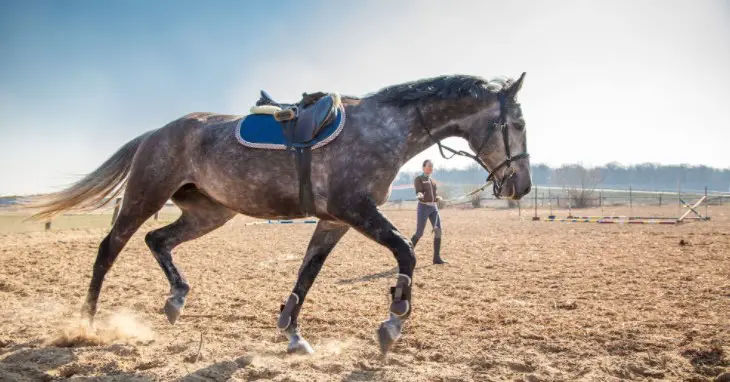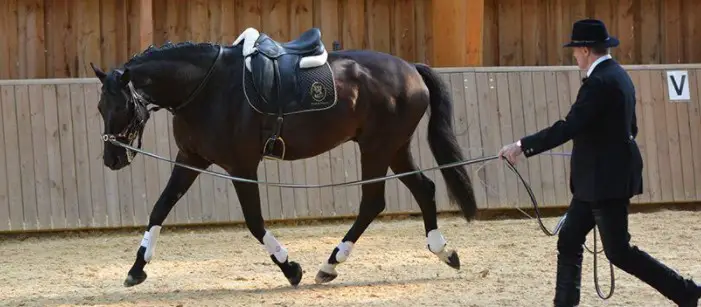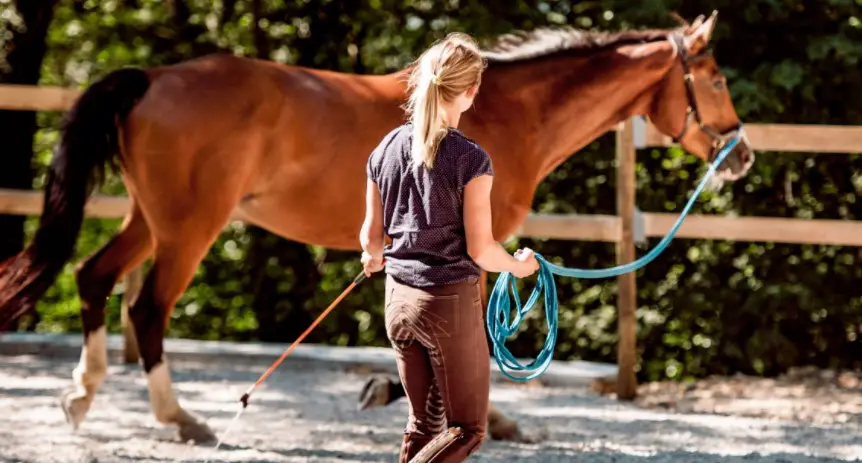Are you planning to have your horse burn off excess energy without a ride? Consider lunging your horse. You can do that by making it move around you in a circle. Furthermore, you’ll have to properly use your body language and voice for more effortless engagement of your horse.
Lunging is essential for a horse, and apart from just exercising, you can build trust between yourself and the horse. Moreover, the animal may also be well balanced and flexible. In this article, we’ll look at a step-by-step guide on how to lunge a horse. Stick around to learn more.
Items Your Horse Will Need
- Lunge cavesson to help control the horse without making them feel uncomfortable
- Bandages or protective boots
- Lunge whip
- Lunge line
Items You Need for Yourself
- A helmet
- Gloves to prevent you from getting rope burns due to the horse pulling
- Comfortable boots to avoid sliding
How to Lunge a Horse
The following steps will help you lunge your horse effortlessly.

1. Take Your Horse into a Ring
You will require a space of approximately fourteen to fifteen meters for the horse. This will enable it to have sufficient space to trot. Besides, you need to ensure it’s not too much as it can make you feel like you are in an open place, resulting in the horse trying to run away. Therefore, if you can’t access a ring, you may use hay bales to help produce a circle if you don’t have a paddock or corral.
2. Hold a Whip and Lunge Line
Hold the lunge line depending on the side your horse will be using. If the rein is on the left, ensure the whip is on your right, and the lunge line is on the left. Hold the whip to your left and the line on your right if it operates from the right rein. Also, ensure both the whip and the line are triangular sides, and you be the apex of the formed triangle. The horse will be its base. Ensure you bend your arms at your elbow, and you’re relaxed while standing.
3. Command the Horse to Start Walking
To command a horse to walk, consider using a sound or a word of your choice. However, ensure you are consistent with their use. If you choose to go with a clicking sound to make it walk, you should use that all the time. Consider using different tones for every command and keep the verbal commands low. If you talk continuously, your horse will begin tuning out your voice.
4. Maintain the Circle You Form
Avoid dragging the lunge line on the ground as the horse moves in the circle. Hold it up and keep the elbows bent and whip pointing at the hocks of the horse. Also, maintain a triangle shape and walk in the same direction as your horse in a smaller circle.
5. Do the Upward and Downward Transitions
When performing the upward transitions, consider using your voice. For instance, it may range from trot to canter, and you can enhance this by using the whip. For some, you may have to crack the lash, while for others, it’ll just take the whip’s wave. You may have to perfect this by practicing before you try to lunge a horse. As for the downward transition, it may range from trot to stop, canter to walk, walk to stop, or trot to walk. You can try to lower the whip’s tip to the ground.
6. Halt the Horse
Asking a horse to stop will mean they should remain in the circle while waiting for you to move to them. However, you may still let them come to you when you call out. With this, you can collect the lineup so it does not get dragged on the ground as your horse proceeds towards you.
What Are Good Practices When Lunging Horses?
There are several things you need to do to make the training more productive. Let’s look at some of the essential practices.

Change Direction Often
You can switch directions every five minutes. Take note that, at times, the training can be redundant for you and the horse. A change can protect your brain and muscles from fatigue. Consider taking advantage of walking breaks and tack adjustments to change direction; this will prevent you from feeling like starting or stopping every time.
Maintain Contact With the Horse
A continuous connection between the horse and yourself is vital for perfect lunging. Though you may come across those who lunge with a slackline with no contact at all, it’s not advised if you’re just starting. The main reason for this is a majority of the horses usually avoid the bending effect of the lunge line’s connection. This can be through falling in the circle and can take a skillful use of a whip and patience to correct it. Remember, when you lunge a horse without contact on the lunge line, you will be training with no bend, which isn’t helpful.
Ensure the Circle is Large and round
The circle needs to range between fifteen to twenty meters. It needs to be large enough to accommodate your horse. Besides, you can make it bigger by allowing more of the rope out. It would be best to realize that when you use a smaller circle, your horse’s legs will find it hard.
If you begin walking in the center of the ring, your horse’s circle will have to adjust to the shape you establish. And if it can’t make a proportional circle due to its changing shape, the horse won’t engage and get the round shape you need.
Avoid Overworking the Stiff Side
Horses have a weak side, just like human beings, and it manifests as a stiff side. Even though you may be tempted to use this side more, ensure you avoid it. Lunging needs to be accomplished evenly on each side to have a supportive muscle that creates elasticity and balance.
Ensure the Lunge Line Is Well Organised
Check to ensure the lunge line is not twisted as it will allow you to have clear communication. When you hold the line with both of your hands, you will be able to feed and collect the lunge line as required. Avoid wrapping the extra line around your hand while you lunge a horse. In the event of the horse bolting or spooking, your hands may get stuck, and you’ll end up being dragged.
How Long Should You Lunge Your Horse?
You should lunge a horse for fifteen or twenty minutes. This amount of time can be helpful if you lunge once a week to make your horse fit and strong. If you go past this duration, its joints may strain. Ensure you walk on either side for the first five minutes to let your horse stretch and unwind.

Consider maintaining an active walk, though not a rushed one. Also, encourage it to utilize the topline more often. For the next ten minutes, you can choose a pace based on the training objective and whether the horse benefits from moving into canter or trot after a walk.
You can then take ten to fifteen minutes for a more advanced workout after it loosens up. Be cautious, so you don’t tighten the lunging aids excessively since you don’t want to tie its head down. All you can do is concentrate on encouraging your horse to engage his back and operate on the topline.
You can take off the lunging aids and then take a few minutes for your horse to stretch and relax when you finish. This can be through a short stretchy trot and walking for the remaining time. Ensure you do this until his heartbeat slows down and the body temperature returns to normal.
Conclusion
As you can see, you can easily lunge a horse. Lunging has many advantages for both the horse and rider since they all get to engage their bodies. Ensure you do everything correctly and consistently for the required time. Also, exercise patience as you proceed with the training if you want to be more productive.
